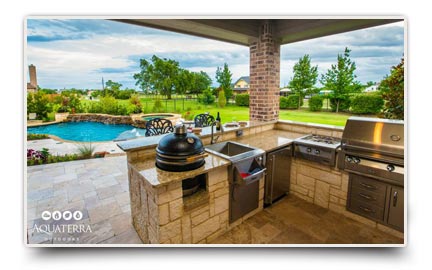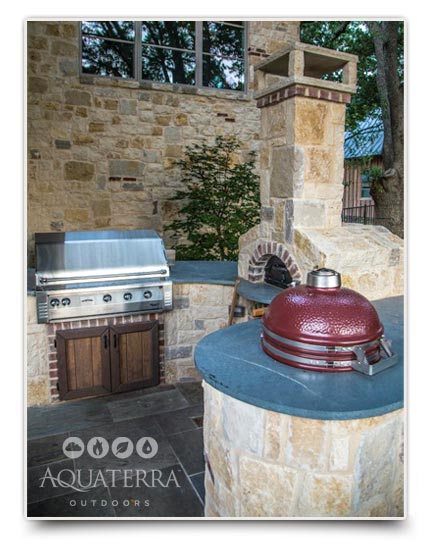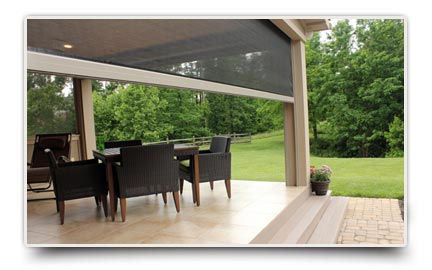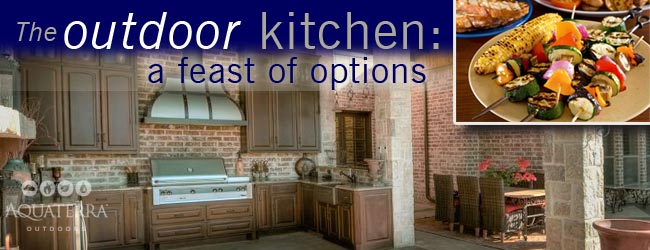A feast of options for your outdoor kitchen space
Outdoor grilling has become one of the great American ways to enjoy a meal in outdoor kitchens. Just ask grill manufacturers! With the advent of increasingly sophisticated, no fuss, gas-burning grills of all styles and dimensions, cooking outdoors has become a regular weekday treat as well as the centerpiece of a holiday or weekend party.
 Some things become quickly apparent when people start using their grill a lot, especially as they get into more than steaks and hamburgers. They need more “stuff” at their immediate disposal to keep from scurrying in and out of the house. Because of this, many people have found, in fact, that what they need is an outdoor kitchen, and this trend has started to grow on a scale more than commensurate with the new grills that have been evolving in recent years.
Some things become quickly apparent when people start using their grill a lot, especially as they get into more than steaks and hamburgers. They need more “stuff” at their immediate disposal to keep from scurrying in and out of the house. Because of this, many people have found, in fact, that what they need is an outdoor kitchen, and this trend has started to grow on a scale more than commensurate with the new grills that have been evolving in recent years.
If people are considering an outdoor kitchen or simply upgrading their cooking area a bit, here are a few questions they should ask:
- What kind of cooking will I do and how often?
- What kind of space will I need for the entertaining/cooking I want to do?
- What are the elements that will fit into and be most useful for this space?
- What kind of environmental factors must I address? Is the area sunny or shady or both at different times of the day? Do I live in an area where insects, rodents or other small pests can be a factor when there is food around? Do I have options if it’s raining?
 Here are some of the things to consider for each of these questions:
Here are some of the things to consider for each of these questions:
No. 1: What kind of cooking will I do? Nowadays grills are made to dish up a variety of food. Grill accessories include a griddle, baskets for grilling fish and vegetables, different levels of cooking space for different heat requirements, and side burners. If you’re in a southern climate outdoor cooking can be done almost year around. At the same time, in northern climates many people want to enjoy the outdoors as much as they can while the weather is warm.
No. 2: What kind of space will I need? It’s important for people to give themselves and their guests enough space to comfortably and conveniently cook, eat, move around and access other outdoor features like pools, playgrounds and gardens. In the food preparation and dining area, recommendations include:
- 36 inches of workspace on either side of the grill and burners
- 18 to 24 inches of space either side of a sink
- 36 to 42 inches between the edge of the dining table and whatever is around it so people can walk behind the chairs. Also place tables away from any stairs.
- If using an eating counter, 24 inches per stool width and 15 inches of legroom.
No. 3: What are the elements that will fit into and be most useful for this space? People should give themselves enough workspace on either side of the grill for one thing, noting the recommendation above, and make sure the surface is easy to clean. They should make sure there is enough direct light from whatever source to enable them to see clearly what they are cooking, while candles or more diffuse lighting can help set the mood in other spots for evening affairs. Other elements can include:
- A refrigerator.
- A sink, connected either to a hose or direct water line. Hot water usually isn’t
- An exhaust hood for grill to keep smoke away from diners.
- Warming drawers.
- Cabinets for storing ingredients and tableware and cooking implements.
- A microwave for quick warm-ups, side dishes and snacks like popcorn.
- A wood-burning oven for roasting meats and vegetables and making pizzas.
- Handily located GFCI electrical outlets.
- Ice machine
- Wine storage needed unless washing dishes outside.
Also persons should consider whether these elements may need to be moved at some point. So in that case they’d want to get a grill with wheels, for example.
 No. 4: What kind of environmental factors must I address? As for managing environmental factors, this is where Stoett screens become an especially great asset. These customized screens can be automatically raised or lowered to provide protection from the sun and UV rays along with natural shade cooling on hot days. Combined with overhead cover, Stoett screens can help keep out rain and flying debris when a storm breaks, protecting both guests and kitchen elements. Custom configurations for outdoor kitchens also add privacy — including privacy from insects and small critters! People may not know what’s lurking around their place until they start cooking out a lot. Screen enclosures keep guests free of insect bites and protect food from contamination.
No. 4: What kind of environmental factors must I address? As for managing environmental factors, this is where Stoett screens become an especially great asset. These customized screens can be automatically raised or lowered to provide protection from the sun and UV rays along with natural shade cooling on hot days. Combined with overhead cover, Stoett screens can help keep out rain and flying debris when a storm breaks, protecting both guests and kitchen elements. Custom configurations for outdoor kitchens also add privacy — including privacy from insects and small critters! People may not know what’s lurking around their place until they start cooking out a lot. Screen enclosures keep guests free of insect bites and protect food from contamination.
All these elements together have the effect of adding another “room” to a house — an add- on that combines the great flavor of the outdoors with the ease and comforts of indoor cooking and dining.
For most people, it doesn’t get much better than that!

Images used: Design and construction by AquaTerra Outdoors, photography by Daniel Driensky
Source: Lowes.com


